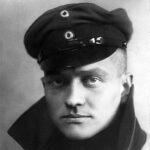
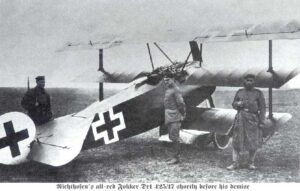 There were amazing pilots on both sides of World War I. One fighter pilot who really stood out as a superstar was Baron von Richthofen, known to the world as the Red Baron. The Red Baron was born on May 2, 1892, into a family of Prussian nobles. Growing up in the Silesia region of what is now Poland, he lived the kind of life you would expect of a nobleman. He passed the time playing sports, riding horses, and hunting wild game, a passion that would follow him for the rest of his life. As was common and on the wishes of his father, Richthofen was enrolled in military school at age 11. Many people felt that military school would provide the best discipline and training, especially if one were going to be an officer. Shortly before his 18th birthday, he was commissioned as an officer in a German cavalry unit.
There were amazing pilots on both sides of World War I. One fighter pilot who really stood out as a superstar was Baron von Richthofen, known to the world as the Red Baron. The Red Baron was born on May 2, 1892, into a family of Prussian nobles. Growing up in the Silesia region of what is now Poland, he lived the kind of life you would expect of a nobleman. He passed the time playing sports, riding horses, and hunting wild game, a passion that would follow him for the rest of his life. As was common and on the wishes of his father, Richthofen was enrolled in military school at age 11. Many people felt that military school would provide the best discipline and training, especially if one were going to be an officer. Shortly before his 18th birthday, he was commissioned as an officer in a German cavalry unit.
Richthofen transferred to the Air Service in 1915, and in 1916 he became one of the first members of fighter squadron Jagdstaffel 2. He was a natural and quickly distinguished himself as a fighter pilot. Then, in 1917 became the leader of Jasta 11. He would go on to lead the larger fighter wing Jagdgeschwader I, which was also known as “The Flying Circus” or “Richthofen’s Circus” mostly because of the bright colors of its aircraft, but maybe because of the way the unit was transferred from one area of Allied air activity to another. When units were moved, it was like a travelling circus. They moved and often set up in tents on improvised airfields.
Between September 1916 and April 1918, he shot down 80 enemy aircraft. That was more than any other pilot during World War I. The Red Baron once wrote, “I never get into an aircraft for fun. I aim first for the head of the pilot, or rather at the head of the observer, if there is one.” He was well known for his crimson-painted Albatros biplanes and Fokker triplanes, and the “Red Baron” by 1918, Richthofen was regarded as a national hero in Germany, and strangely, Richthofen was even respected by his enemies, which is very rare indeed.
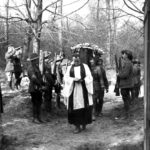
Loyal to the end, Richthofen received a fatal wound while flying over Morlancourt Ridge near the Somme River, just after 11:00am on April 21, 1918. He had been pursuing, a Sopwith Camel piloted by Canadian novice Wilfrid Reid “Wop” May of the Number 209 Squadron, Royal Air Force. May had just fired on the Red Baron’s cousin, Lieutenant Wolfram von Richthofen. When he saw his cousin being attacked, the Red Baron flew rescue him. He fired on May’s plane, causing him to pull away, then he chased May across the Somme. The Baron was spotted and briefly attacked by a Camel piloted by May’s school friend and flight commander, Canadian Captain Arthur “Roy” Brown. Brown had to dive steeply at very high speed to intervene, and then had to climb steeply to avoid hitting the ground. Richthofen turned to avoid this attack, and then resumed his pursuit of May.
During this final stage in his pursuit of May, Richthofen was hit by a single .303 bullet through the chest, severely damaging his heart and lungs. He would have bled out in less than a minute. Now pilotless, the plane stalled and went into a steep dive. It hit the ground in a field on a hill near the Bray-Corbie Road, just north of the village of Vaux-sur-Somme. This was in a sector defended by the Australian Imperial Force (AIF). The plane bounced heavily when it hit the ground, and the undercarriage collapsed. The fuel tank was smashed before the aircraft skidded to a stop. Several witnesses, including Gunner George Ridgway, reached the crashed plane and found Richthofen already dead, and his face slammed into the butts of his machine guns, breaking his nose, fracturing his jaw and creating contusions on his face.
Number 3 Squadron AFC’s commanding officer Major David Blake, who was responsible for Richthofen’s body, regarded the Red Baron with great respect. It was Blake who was responsible for organizing the funeral, and he decided on a full military funeral. Richthofen’s body was buried in the cemetery at the village of Bertangles, near Amiens, on April 22, 1918. Six of Number 3 Squadron’s officers served as pallbearers, and a guard of honor from the squadron’s other ranks fired a salute. Allied squadrons stationed nearby presented memorial 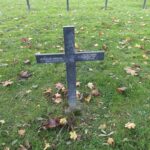
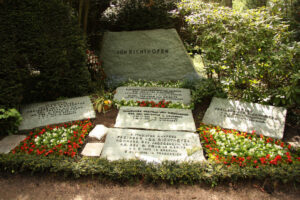 wreaths, one of which was inscribed with the words, “To Our Gallant and Worthy Foe.” It was an extremely respectful way to care for the body of the enemy, and for that, I have much respect for the Number 3 Squadron. Even though this man was the enemy, they knew he was just doing his job, as they would do theirs. It wasn’t personal, it was just war. In 1975 the body was moved to a Richthofen family grave plot at the Südfriedhof in Wiesbaden.
wreaths, one of which was inscribed with the words, “To Our Gallant and Worthy Foe.” It was an extremely respectful way to care for the body of the enemy, and for that, I have much respect for the Number 3 Squadron. Even though this man was the enemy, they knew he was just doing his job, as they would do theirs. It wasn’t personal, it was just war. In 1975 the body was moved to a Richthofen family grave plot at the Südfriedhof in Wiesbaden.


Leave a Reply